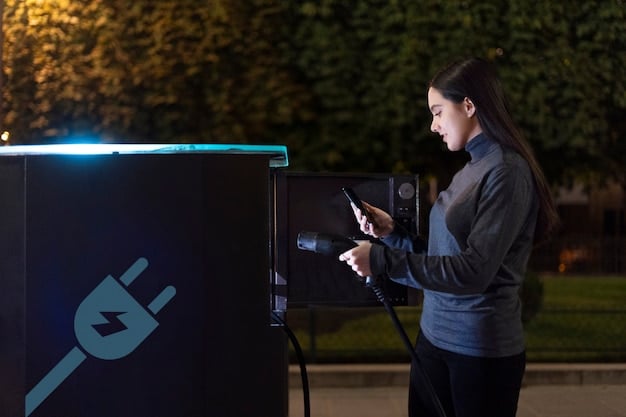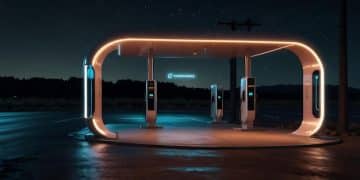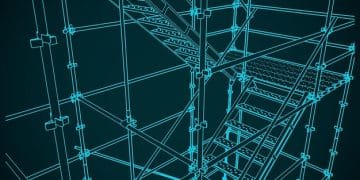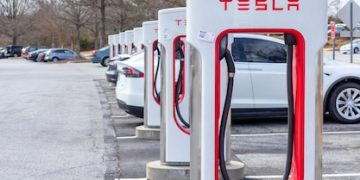US Infrastructure Bill: EV Charging Station Expansion by 2025

The US Infrastructure Bill is set to significantly accelerate the deployment of electric vehicle (EV) charging stations across the nation by 2025, with substantial funding allocated to expand charging infrastructure and encourage EV adoption.
The US Infrastructure Bill represents a pivotal moment for the electric vehicle (EV) industry, particularly concerning the expansion of charging infrastructure across the nation. As we move closer to 2025, the impact of this bill is becoming increasingly apparent, promising a significant boost to the deployment of electric vehicle charging stations.
The Infrastructure Investment and Jobs Act: A Catalyst for EV Growth
The Bipartisan Infrastructure Law, officially known as the Infrastructure Investment and Jobs Act (IIJA), was signed into law with the goal of modernizing America’s infrastructure. A significant portion of this investment is dedicated to accelerating the adoption of electric vehicles. This section explores how this Act serves as a catalyst for the EV market.
Funding and Investment
The IIJA allocates billions of dollars to support the development of a national network of EV chargers. This funding is intended to address the current недостаток of charging stations, especially in rural and underserved areas.
NEVI Formula Program
A core component of the infrastructure bill that directly impacts the deployment of EV charging stations is the National Electric Vehicle Infrastructure (NEVI) Formula Program. We need to understand its objectives and mechanisms.
- State-Led Initiatives: The NEVI program allows each state to create its own plan for deploying EV charging infrastructure, with federal funds covering up to 80% of the costs.
- Focus on Highway Corridors: A primary focus of the NEVI program is to strategically place EV charging stations along major highway corridors to facilitate long-distance travel.
- Minimum Standards and Requirements: The program establishes minimum standards for the charging stations, including requirements for the number of chargers, charging speed, accessibility, and reliability.
- Public-Private Partnerships: The NEVI program encourages partnerships between state authorities and private companies to leverage expertise and private capital in the deployment process.
By strategically investing in charging infrastructure, the IIJA aims to alleviate range anxiety among potential EV buyers and make electric vehicles a more viable option for a broader segment of the population. This will encourage more people to switch to EVs, leading to a cleaner and greener transportation sector.
States Leading the Charge in EV Infrastructure Development
Several states have taken the lead in implementing innovative strategies to expand their EV charging networks. These states serve as models for others aiming to capitalize on the opportunities presented by the Infrastructure Investment and Jobs Act. This part focuses on the states that have shown initiative.
California’s Ambitious Goals
California aims to ban the sale of new gasoline-powered vehicles by 2035 and is investing heavily in EV infrastructure to support this transition. The state has already installed thousands of public charging stations and has plans for thousands more.
New York’s EVolve NY Initiative
New York’s EVolve NY initiative is another example of a state-level effort to accelerate EV adoption through strategic infrastructure investments. The program focuses on deploying high-speed charging stations along key transportation corridors and in urban areas.
- Strategic Partnerships for Success: These state initiatives often involve partnerships between government agencies, private companies, and local communities.
- Incentives and Rebates: Many states offer incentives and rebates to encourage the installation of EV charging stations at homes, workplaces, and public locations.
- Focus on Disadvantaged Communities: The states have focused on EV infrastructure developments in disadvantaged communities of low income.
These states offer valuable lessons for other regions on how to effectively leverage federal funding, foster collaboration, and prioritize strategic investments to accelerate the deployment of electric vehicle charging stations.

The Role of Private Sector Innovation
While the Infrastructure Bill provides a foundation, the private sector plays a crucial role in driving innovation and expanding the accessibility of EV charging infrastructure. This section explores the contributions of private companies to the EV charging ecosystem.
Charging Network Operators
Companies like Tesla, Electrify America, and ChargePoint are rapidly expanding their charging networks across the country. They are investing in faster charging technologies, expanding the number of charging locations, and enhancing the overall user experience.
Technology Advancements
Private companies are also pioneering technology advancements that are making EV charging faster, more convenient, and more efficient. Examples include wireless charging, battery swapping, and smart charging technologies that can optimize energy consumption.
- Wireless Charging: Wireless charging technology is gaining traction, offering a hands-free charging solution for EVs.
- Smart Charging: Smart charging technologies allow EVs to communicate with the grid and optimize charging times based on energy demand and pricing signals.
- Battery Swapping: Battery swapping stations, where depleted batteries are quickly replaced with fully charged ones, are an alternative to traditional charging.
The combination of government support and private sector innovation is creating a dynamic ecosystem that is driving the rapid expansion of EV charging infrastructure. This synergy will be essential to meeting the growing demand for electric vehicles in the years to come.
Challenges and Opportunities in EV Charger Deployment
While the Infrastructure Bill provides unprecedented support for EV charging infrastructure, there are still challenges to overcome and opportunities to seize. Considering the issues in EV development is essential.
Permitting and Zoning
One of the primary hurdles is the complex and time-consuming permitting and zoning processes for installing EV charging stations. Streamlining these processes will be critical to accelerating deployment.
Grid Capacity and Upgrades
Another challenge is ensuring that the power grid can handle the increased demand from EV charging. Upgrades to the grid infrastructure may be necessary to support widespread EV adoption.

- Standardization and Interoperability: Ensuring that all EV charging stations adhere to common standards and protocols will be essential for seamless user experience.
- Addressing Rural and Underserved Areas: Special efforts are needed to ensure that EV infrastructure is accessible in rural and underserved areas, where charging options are often limited.
- Public Awareness and Education: Raising public awareness about the benefits of electric vehicles and the availability of charging infrastructure is crucial for driving adoption.
By addressing these challenges and seizing the opportunities, the United States can accelerate the transition to electric vehicles and reap the environmental and economic benefits of a cleaner transportation sector.
The Impact of the Infrastructure Bill on EV Adoption Rates
The expansion of EV charging infrastructure is expected to have a significant impact on the adoption rates of electric vehicles. Addressing the impact that the bill brings is essential for the stakeholders.
Alleviating Range Anxiety
One of the primary barriers to wider EV adoption is range anxiety, the fear of running out of battery before reaching a charging station. By increasing the availability of charging stations, the Infrastructure Bill will help alleviate this anxiety and make EVs more attractive to potential buyers.
Incentivizing EV Purchases
The Infrastructure Bill also includes provisions for consumer incentives, such as tax credits for purchasing EVs. These incentives, combined with the expansion of charging infrastructure, will help drive down the cost of EV ownership and make them more accessible to a broader range of consumers.
- Lower Total Cost of Ownership: EVs have a lower total cost of ownership compared to gasoline-powered vehicles due to lower fuel and maintenance costs.
- Government Incentives and Rebates: The bill helps to incentivize EV purchases with rebates for the users.
- Growing Availability of EV Models: The growing availability of EV models, including sedans, trucks, and SUVs, is also contributing to increased consumer interest in electric vehicles.
As more consumers experience the benefits of EV ownership, the demand for electric vehicles is likely to increase, further accelerating the transition to a cleaner transportation sector.
Looking Ahead: The Future of EV Charging in the US
As we look ahead to 2025 and beyond, the future of EV charging in the United States looks promising. We need to be aware and ready for the future.
Continued Infrastructure Development
The Infrastructure Investment and Jobs Act is just the first step in a long-term effort to build out a comprehensive EV charging network across the country. Continued investment and innovation will be essential to keeping pace with the growing demand for electric vehicles.
Technological Advancements
Technological advancements in EV charging technology, such as faster charging speeds and wireless charging, will continue to improve the user experience and make EV ownership more convenient. New technologies will enhance EV usage experience.
- Standardization and Interoperability: Standardization and interoperability are crucial to ensure smooth user access to charge everywhere.
- Integration with Renewable Energy Sources: Powering EV charging stations with renewable energy sources, such as solar and wind, will further reduce the carbon footprint of electric vehicles.
- Smart Grid Integration: Smart grid integration will allow EVs to communicate with the grid and optimize charging times based on energy demand and pricing signals.
By embracing these trends and continuing to invest in EV infrastructure, the United States can cement its position as a leader in the global transition to electric vehicles.
| Key Point | Brief Description |
|---|---|
| ⚡ NEVI Program | State-led initiatives focusing on highway corridors with minimum charging standards. |
| 💰 Funding & Investment | Billions are allocated to address the shortage of charging stations, especially in rural areas. |
| 🤝 Public-Private Partnership | Encourages partnerships to leverage expertise and capital for deployment process. |
| 🚗 EV Adoption Rates | Expanded EV charging infrastructure will reduce range anxiety and push EV adoption. |
Frequently Asked Questions
▼
The primary goal is to significantly expand the number of EV charging stations across the United States, particularly along major highway corridors and in underserved communities, to support the growing adoption of electric vehicles.
▼
The NEVI Formula Program provides funding to states to develop their EV charging infrastructure plans. It prioritizes strategic placement and compliance with minimum standards to ensure reliability and accessibility for long-distance travel.
▼
Challenges include navigating complex permitting and zoning processes, ensuring sufficient grid capacity to handle increased demand, and addressing standardization and interoperability issues across different charging networks.
▼
By alleviating “range anxiety” through expanded charging infrastructure, and by providing consumer incentives like tax credits, the Bill aims to make EV ownership more appealing and affordable, thus driving up adoption rates.
▼
Private companies are developing innovations (like faster charging), expanding charging networks, and pioneering battery technologies. Their synergy with government support is crucial for meeting EV charging demands in the US.
Conclusion
The US Infrastructure Bill marks a significant step forward in the development of electric vehicle charging infrastructure. Through strategic investments, innovative programs, and collaboration between the public and private sectors, the nation is poised to accelerate the transition to electric vehicles, reduce emissions, and create a more sustainable transportation future. Looking towards 2025, the groundwork laid by this bill promises a cleaner and more efficient transportation landscape for all Americans.





